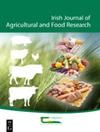Impact of a total mixed ration or pasture/pasture silage-based feeding strategy in the initial stages of lactation of spring-calving dairy cows on milk production, composition and selected milk processability parameters
IF 1.4
4区 农林科学
Q3 AGRICULTURE, MULTIDISCIPLINARY
引用次数: 1
Abstract
The objective of this experiment was to investigate the effect of feeding strategy on milk production, composition and selected processability parameters in the initial stages of lactation. Twenty Holstein Friesian cows were allocated to one of two dietary treatments (n = 10; 7 multiparous and 3 primiparous) in a randomised complete block design for 21 d from day 10 to day 31 post-calving. Treatment 1 (pasture-based system [PBS]) was a pasture/pasture silage-based diet where cows were offered ad libitum grazed pasture or pasture silage (when weather did not permit grazing) plus 3 kg DM/d or 5 kg DM/d concentrate supplementation, respectively. On average, cows grazed pasture for 7.5 d and were fed pasture silage indoors for 13.5 d. Treatment 2 (TMR) was a total mixed ration (TMR) diet made up of concentrate, plus maize silage, pasture silage, beet pulp, soya bean meal and straw. Multiparous cows were blocked on calving date and balanced for parity and milk yield. Primiparous cows were balanced for live weight. Milk attributes pertinent to composition and functionality (e.g., fatty acids and rennet coagulation time [RCT]) were examined over a 21-d experimental period from day 10 to day 31 post-calving. Cows offered PBS tended to have a lower test day milk yield (PBS = 24.2 kg/cow vs. TMR = 26.8 kg/cow, P = 0.09) and a greater milk urea nitrogen (MUN) content compared to TMR (PBS = 0.030 g/100 g milk vs. TMR = 0.013 g/100 g milk, P < 0.001). Most notably, PBS-derived milks had a greater (P < 0.001) concentration of cis-9 trans-11 conjugated linoleic acid (CLA) compared to TMR. In conclusion, milk produced during early lactation from both feeding strategies was suitable for processing. Feeding a TMR compared with ad libitum pasture/pasture silage had no impact on average milk pH, casein concentration or RCT. Cows fed a pasture/pasture silage-based diet produced milk with a desirable RCT for milk processing, while the higher MUN content from cows offered PBS did not impact the processability of milk. Furthermore, milk from cows offered PBS had greater concentrations of cis-9 trans-11 CLA, which may offer human health benefits.春季产仔奶牛泌乳初期的全混合日粮或基于牧场/牧场青贮饲料的喂养策略对产奶量、成分和选定的牛奶加工参数的影响
本实验的目的是研究哺乳初期喂养策略对产奶量、成分和所选加工参数的影响。将20头荷斯坦-弗里斯奶牛分配到两种饮食处理中的一种(n=10;7头多胎和3头初产妇),采用随机完全分组设计,从产仔后第10天到第31天,为期21天。处理1(基于牧场的系统[PBS])是基于牧场/牧场青贮饲料的饮食,其中向奶牛提供随意放牧的牧场或牧场青贮饲料(当天气不允许放牧时),分别加上3 kg DM/d或5 kg DM/d的浓缩物补充。奶牛平均在牧场上放牧7.5天,在室内饲养牧场青贮饲料13.5天。处理2(TMR)是由浓缩物、玉米青贮饲料、牧场青贮饲料、甜菜浆、豆粕和秸秆组成的全混合日粮。多胎奶牛在产仔日期被封锁,并在产奶量和产奶量方面保持平衡。初产奶牛的活重是平衡的。在产仔后第10天至第31天的21天实验期间,对与成分和功能相关的牛奶属性(如脂肪酸和凝乳酶凝固时间[RCT])进行了检查。与TMR相比,提供PBS的奶牛在试验日的产奶量往往较低(PBS=24.2 kg/cow vs.TMR=26.8 kg/cow,P=0.09),奶中尿素氮(MUN)含量更高(PBS=0.030 g/100 g牛奶vs.TMR=0.013 g/100 g奶,P<0.001)。最值得注意的是,PBS来源的牛奶与TMR相比具有更高的顺-9反-11共轭亚油酸(CLA)浓度(P<0.001)。总之,两种喂养策略在哺乳早期产生的乳汁都适合加工。与随意饲养的牧场/牧场青贮饲料相比,饲喂TMR对平均牛奶pH、酪蛋白浓度或RCT没有影响。饲喂基于牧场/牧场青贮饲料的奶牛生产的牛奶具有用于牛奶加工的理想RCT,而提供PBS的奶牛的较高MUN含量不会影响牛奶的加工性。此外,提供PBS的奶牛的牛奶具有更高浓度的顺-9反-11 CLA,这可能对人类健康有益。
本文章由计算机程序翻译,如有差异,请以英文原文为准。
求助全文
约1分钟内获得全文
求助全文
来源期刊
CiteScore
2.50
自引率
20.00%
发文量
23
审稿时长
>36 weeks
期刊介绍:
The Irish Journal of Agricultural and Food Research is a peer reviewed open access scientific journal published by Teagasc (Agriculture and Food Development Authority, Ireland). Manuscripts on any aspect of research of direct relevance to Irish agriculture and food production, including plant and animal sciences, food science, agri environmental science, soils, engineering, buildings, economics and sociology, will be considered for publication. The work must demonstrate novelty and relevance to the field of research. Papers published or offered for publication elsewhere will not be considered, but the publication of an abstract does not preclude the publication of the full paper in this journal.

 求助内容:
求助内容: 应助结果提醒方式:
应助结果提醒方式:


